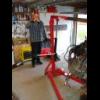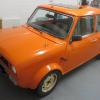Edited by Johnmar, 28 October 2020 - 08:15 AM.
Asking For Mig Welding Instructions
#1

Posted 28 October 2020 - 08:05 AM
#2

Posted 28 October 2020 - 08:26 AM
Power again depends on the welder you use.
Now a lot depends on your welder itself, that’s the crucial part. Each one out there has different settings so it’s not straight fwd to advise on what settings to use.
The area I weld I make sure it’s well lit so you can where you are going to weld. No point in flailing around trying to find it. With a plug weld I tend to start at the top of the hole and then move back / down. If you are welding directly on top you can start from the centre. You need to adjust to the position your area of welding is.
And I use reading glasses behind my mask.
With regards to lighting I use a couple of things. I have some torches with magnets on the back to use in tighter areas like under the wings or rear arches. Anywhere else I use your average mains powered working light with a hook.
#3

Posted 28 October 2020 - 09:45 AM
Thank you big time Sonikk4 for your response and taking the time!!
I just bought a dimmable torch (light not welding) with magnetic base, just for this purpose. Reading that you also take real care of how things are lit makes me not longer feel like a dumbass in this. Will try out what you suggested.
With a plug weld I tend to start at the top of the hole and then move back / down. If you are welding directly on top you can start from the centre. You need to adjust to the position your area of welding is.
"At the top of the hole and then move down": not completely sure what you mean here.
Can you ellaborate a bit more on this (it is lost in translation at my end) .
And is that independent of the orientation of your plugweld (horizontal/vertical)?
Edited by Johnmar, 28 October 2020 - 09:46 AM.
#4

Posted 28 October 2020 - 11:41 AM
Now if you are looking straight down onto the weld then starting in the middle is not such an issue.
#5

Posted 28 October 2020 - 02:12 PM
if needed I use led spot lights for welding, I also find making a sort of cape for the welding helmet useful so it blocks light coming into the mask.
#6

Posted 28 October 2020 - 02:22 PM
My welding is som much better when the area is well lit. I have a rechargeable LED alight with magnetic base from Lidl, its very good.
I have a clip on reading lamp form Ikea with LED bulb, very helpful.
Plug welding as so much easier and successful if thy can see the hole and the puddle.
good luck
#7

Posted 28 October 2020 - 02:37 PM
if needed I use led spot lights for welding, I also find making a sort of cape for the welding helmet useful so it blocks light coming into the mask.
Thought it was just me. I've got a clear plastic roof at the back of my garage and I end up under a sheet of cardboard to keep the light from flooding the back of the helmet.
I like the cape idea, I've got some stick on velco strips so it's not permanent ![]()
#8

Posted 28 October 2020 - 03:49 PM
Good to read that you all take extra care lightning wise. Means that I was on the right track there.
I will try all your advise/tips and will report back to you in this thread.
#9

Posted 28 October 2020 - 03:50 PM
Ok to elaborate. If you are welding vertically then starting at the top of the hole will allow the puddle of weld to fill the hole as you move down. If you were to start from the middle or the bottom of the hole then you have to move up. You can use this technique if the area you are welding is angled.
Now if you are looking straight down onto the weld then starting in the middle is not such an issue.
Now I understand what you meant with "top". Thanks!
#10

Posted 28 October 2020 - 08:26 PM
First some thoughts on welding masks. I have used a Speedglass auto darkening mask for many years, and have never found any problems either working outside in bright sunlight or in the workshop. A good quality mask, as the Speedglass is, is a neat fitting mask and never gives any backlight problems. Keeping the lenses and filters clean are important for good operation. When not welding the view through the mask is no darker than a pair of poloroid sunglasses so the workpiece is clear enough to carry out non welding work, grinding excepted. If you need extra light on the workpiece you could try attaching a head torch to the mask and focus it onto the work area. To sum up use a good quality mask, keep it clean and when not in use store it in its box or in a dustproof bag.
Turning to plug welding and welding technique. Metalwork has to be clean, as with any welding, and the two plates clamped tightly together with no gap. Hole size either 5mm or 6mm with any burrs ground off. Regarding welder settings I personally turn my welder up to a high current setting and a fast wire speed, cutting the end of the wire after every weld to give a good "point" to start each weld. If you can get to the back side of the joint a heat sink is a good idea. I start in the middle, get good penetration and work in a circular motion round the hole. Over head, downward or angled I use the same technique. The whole operation is over in a "flash" as it were, and you end up with a neat "mushroom" look weld. Its practice makes perfect and after the first 500 or so you will have got it. Some welding machines have a spot weld timer, this helps to give good consistent welds, my Lincoln 180 does not but you get a feel for it. Wire size 0.6mm. So its high welder settings, clean workpiece and practice.
#11

Posted 29 October 2020 - 08:28 PM
I recently bought a new welding helmet that is virtually clear until strike up makes things far easier in low light conditions, they used to be very expensive but have been copied now so are reasonable price,
1 user(s) are reading this topic
0 members, 1 guests, 0 anonymous users















